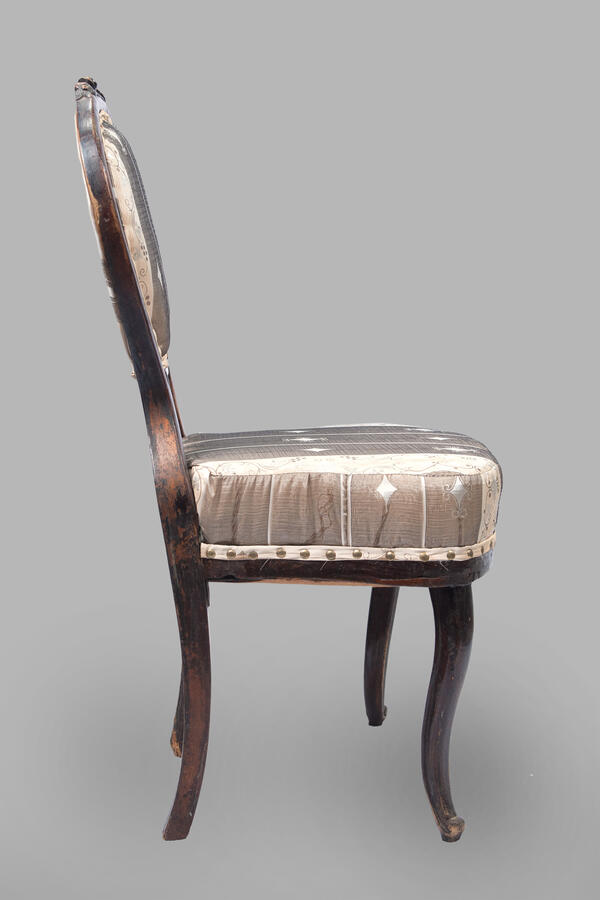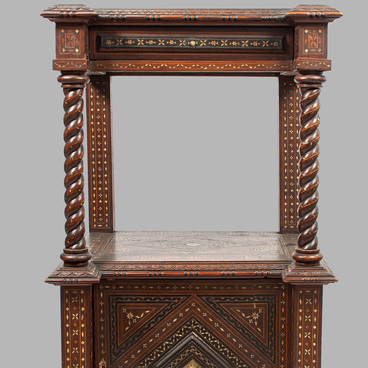Among the exhibits at the Kirsanov Local History Museum are several antique chairs. This chair belonged to Elena Mikhailovna Boratynskaya, grandniece of the famous poet Yevgeny Abramovich Boratynsky. The seat is padded and trapezoidal in shape. Its corners and front side are rounded. The backrest and legs are carved. The chair was most likely stored in a rented flat in Pushkinskaya Street in Kirsanov, where Elena Mikhailovna lived until 1953. During the move to Irkutsk, the furniture and large items could not be taken with her.
The chair only came to the Kirsanov Local History Museum in 1977, presumably from a friend of Elena’s who she had stayed with before she left for Irkutsk. It was a rarity and a symbol of the prestige and wealth of its owner.
Until the late 17th century, chairs, along with armchairs, were not common in Russia. By that time, the benches in the reception rooms of the tsar’s palace began to be replaced by rows of chairs, which was one of the first steps towards the general Europeanisation of the Russian interior.
In Rus, a person who made chairs was called a “stulnik” or “stulshchik”. During the Middle Ages, chairs were very popular in Europe, but only the aristocracy had the chance to sit on them. Just how richly this piece of furniture was decorated directly correlated with the position of the owner in society; moreover, chairs played an important role in the rituals of the palace. However, chairs were not always the epitome of comfort and convenience. In the 17th century, their main characteristic was their majestic appearance. Baroque chairs looked pompous and flamboyant, forcing royalty to sit in uncomfortable positions for hours at court ceremonies.
But the 18th century came and the fickle fashion affected furniture. A new trend was the upholstered and comfortable chairs, in which one could sit for hours in front of a fireplace. There were dozens of types: high barber’s chairs, compact travel ones, elegant armchairs for conversation… Naturally, all these variations of a single chair were available to rich people with high social status, but even they could become hostages of the fashion for this furniture item. When men started to wear tailcoats, they had to sit facing the back of the chair in order not to crumple an important item of their wardrobe. It was only in the second half of the 19th century, when luxury gave way to convenience and chairs became increasingly common among the general public.
The chair only came to the Kirsanov Local History Museum in 1977, presumably from a friend of Elena’s who she had stayed with before she left for Irkutsk. It was a rarity and a symbol of the prestige and wealth of its owner.
Until the late 17th century, chairs, along with armchairs, were not common in Russia. By that time, the benches in the reception rooms of the tsar’s palace began to be replaced by rows of chairs, which was one of the first steps towards the general Europeanisation of the Russian interior.
In Rus, a person who made chairs was called a “stulnik” or “stulshchik”. During the Middle Ages, chairs were very popular in Europe, but only the aristocracy had the chance to sit on them. Just how richly this piece of furniture was decorated directly correlated with the position of the owner in society; moreover, chairs played an important role in the rituals of the palace. However, chairs were not always the epitome of comfort and convenience. In the 17th century, their main characteristic was their majestic appearance. Baroque chairs looked pompous and flamboyant, forcing royalty to sit in uncomfortable positions for hours at court ceremonies.
But the 18th century came and the fickle fashion affected furniture. A new trend was the upholstered and comfortable chairs, in which one could sit for hours in front of a fireplace. There were dozens of types: high barber’s chairs, compact travel ones, elegant armchairs for conversation… Naturally, all these variations of a single chair were available to rich people with high social status, but even they could become hostages of the fashion for this furniture item. When men started to wear tailcoats, they had to sit facing the back of the chair in order not to crumple an important item of their wardrobe. It was only in the second half of the 19th century, when luxury gave way to convenience and chairs became increasingly common among the general public.





